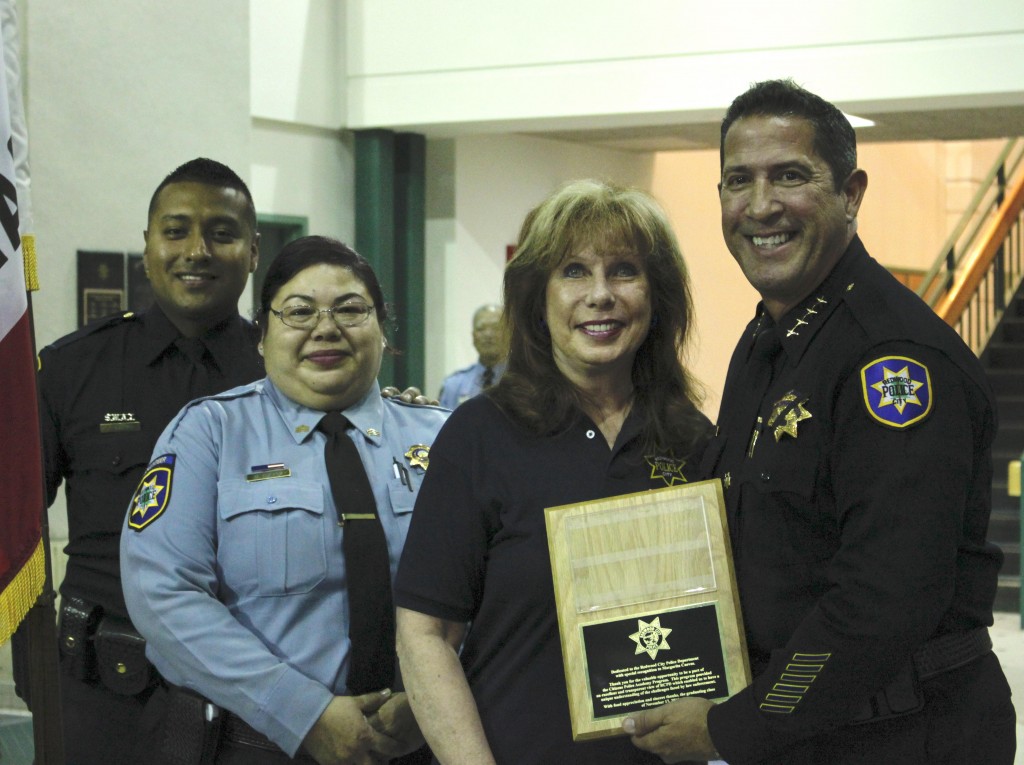Karen Kiehne and her partner arrived at a parking garage known to be a target for break-ins and spotted two men trying to pry open a car’s doors.
Kiehne didn’t hesitate.
“I immediately pull my weapon, and I immediately start yelling at them, ‘I want to see your hands! Get your hands in the air immediately!” she said. “The guy on the passenger side turned around and had a gun in his hand, and I shot him twice.”
“The other guy ran behind a cement wall. And when he came out, I shot him three times.”
But Kiehne isn’t a police officer — she specializes in human resources in the corporate world — and the suspects were just figures on a video screen in the Redwood City Police Department’s training simulator.
Kiehne’s chance to virtually put herself in a cop’s shoes was part of the up-close view of policing she got during the fall session of the Citizens Police Academy.
Every Thursday night for 10 weeks, Kiehne and 19 other civilians spent three hours at the police station learning about officers’ day-to-day activities and the department’s policies. Instructors discussed policing issues like DUI procedure, juvenile justice and human trafficking.
The academy is open to adults from Redwood City and surrounding communities, although people with criminal records are not accepted.
With law enforcement agencies nationwide facing growing scrutiny over accountability and treatment of civilians, Redwood City and several other Bay Area departments have offered a Citizens Police Academy as one way to bridge the gap between officers and residents. By giving participants a look at the inner workings of police departments, the program aims to build trust and bolster community relations.

‘A complete cross-section’
Redwood City’s academy began in 1993, and when JR Gamez became chief of police five years ago, he expanded it to include sessions in Spanish. The academy now includes two to three sessions per year, and Detective Jesse Castro, who teaches the investigations segment, said the department has no trouble filling spots.
Some participants intend to pursue criminal-justice careers, but Kiehne said her classmates also included healthcare workers, housewives and a pastor.
“It was a complete cross-section of nationality, ages,” she said. “And what was so great about that is a lot of those people brought their experiences with the police. And they discussed it, and they got resolution on some items or they got rid of some prejudices.”
Kiehne had a long-held appreciation for police — her father was an officer and she almost became one herself. But Agustin Espino came into the academy with a starkly different outlook.
Espino, who works in manufacturing and recently became a United States citizen, had always been nervous around police. The Redwood City resident believed that any interaction with police would lead to trouble. His instinct to avoid contact with police was reinforced when he reported problems in his neighborhood and officers didn’t seem to do anything.
Espino decided he should try to understand police better. A friend told him about the Citizens Police Academy, and he applied right away.
In the simulator, Espino realized how quickly officers have to make decisions. He was mindful of being hasty, recalling that instructors said police can’t shoot based on what they think a suspect might do — there has to be a direct threat.
But he ended up being too cautious. He was “killed” when a civilian suddenly opened fire.
The academy included a trip to the department’s shooting range, where Espino got instructions on how to use a handgun and then took aim at targets. When instructors, department brass, the students and their families assembled in the police station’s atrium for the graduation ceremony in November, Espino was recognized as one of the top shooters in the class.
Espino also went on a ride-along, accompanying an officer during a shift.
Those first-hand experiences made an impression, and not just because he gained insight into officers’ jobs. Espino said he was surprised civilians got that kind of access and were encouraged to ask any questions they wanted.
Castro, who has been an instructor for three years and will soon be in charge of the academy, said openness is crucial.
“I go out there, and I tell them what I really do at work,” he said. “I don’t tell them everything. But I’m honest with them.”
And when students enter the course with mistrust of police, Castro wants to hear about their bad experiences, especially those involving Redwood City officers. Then, he said, he tries to address the problem, speaking with the officer in question or alerting his supervisors.
Changing perceptions
Now that they’ve completed the academy, Kiehne and Espino hope to join the department’s Volunteers In Police Service (VIPS). Volunteers assist with the academy and other outreach efforts and help paid staff at public events like parades and festivals.
John Spicer, a captain with the police force, said the academy has become a pipeline for Redwood City’s VIPS force, which has grown from four members to 36 in just a few years.
Even if students don’t get involved with the department, Castro thinks the Citizens Police Academy makes a difference. He has seen participants’ perceptions of police change as they’ve gone through the program.
“Well, what happens is they’re comfortable with us, right? Because they’re in a safe environment. Nobody’s being arrested, nobody’s being interrogated or anything like that,” Castro said. “By the end of it, I feel that we become friends. They understand that I’m just like you. I’m a human being.”
Espino underwent that change. If he sees an officer on the street now, he thinks he’ll feel totally differently than he would have just a few months ago.
“I feel like if I see an officer out there, I can get close and say, ‘Hey, how are you doing?’” he said. “I won’t feel that I’m going to get in trouble by getting close to them.”
